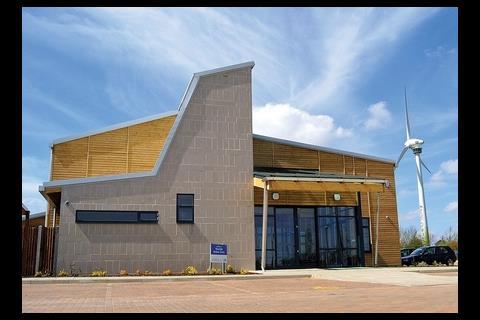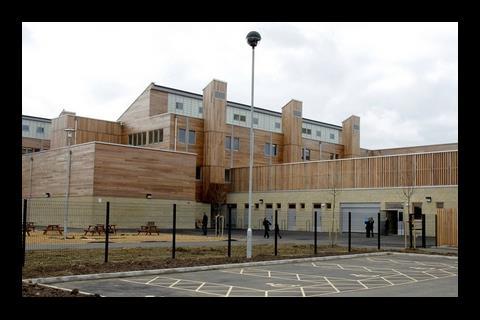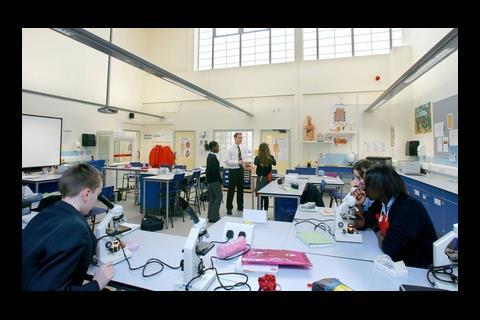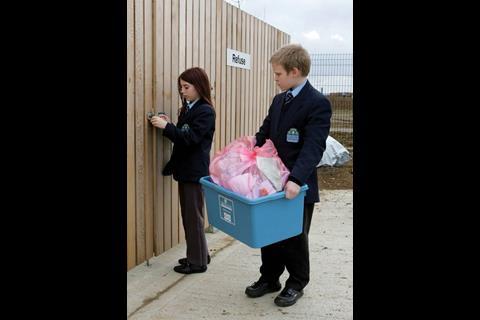For the developers of its hospitals and surgeries, the Department of Health has prescribed a good dose of BREEAM to keep it fit for the future
With a quarter of all hospitals being revamped, 100 to be completed within the next two years and 3,000 GP practices being improved or built, the Department of Health is in the midst of a massive construction programme. And it is determined its schemes will hit high environmental standards.
It is for this reason that the health sector is switching from its in-house environmental self-assessment system to a Bespoke BREEAM. These tailor-made versions of BREEAM help larger clients such as government departments, local authorities and schools set environmental targets. They address issues such as energy use, water pollution, transport, land use and materials and waste during the design and construction phase for new and refurbished buildings.
Since 2002, hundreds of NHS buildings, from hospitals to clinics and health centres, have been assessed under the NHS Environmental Assessment Tool (NEAT), a software tool designed to assess the negative impact of healthcare facilities on the environment. The system was based on BREEAM and now, says Lorraine Brayford, sustainable development programme manager at the Department of Health Estates and Facilities Division, the sector is looking forward to switching to BREEAM Healthcare.
“The beauty of BREEAM is that everyone uses the basic method but it is tailored to specific sectors, so BREEAM for us will be specific to the NHS needs and requirements,” says Brayford. “For example, our disabled access and transport needs are greater perhaps than a retail building, and we have specific energy targets, so the assessment would take that into account.”
Brayford says that while NEAT has been useful, it has “outlived its time”, not least because it is a self-assessment tool, “which means that potentially one individual can interpret aspects of the tool differently to another”. Also, she says, there was a concern that certificates were awarded at the outset of a project, not post-construction. “If a certificate is awarded at the outset, how can you be sure that a building delivers what it promises to deliver?”
BREEAM Healthcare is expected to be more demanding than NEAT, in keeping with current legislation and practice on issues such as energy efficiency. Brayford says that the logistics and cost implications of meeting BREEAM’s standards can be a challenge – for example, ensuring that a BREEAM Healthcare assessor is on board from day one of the project to ensure the building remains on track for a high BREEAM rating. But, she says, it is worth it: “The cost of accreditation is a drop in the ocean compared with the whole-life cost savings. Focusing early on issues such as maintenance, planning, and energy efficiency can give you long-term gain in the life of a building.”
To complement BREEAM, says Brayford, it is important to bring an environmental manager onto the project team to keep an eye on how the scheme is being delivered. He or she will also advise on issues such as reducing energy costs and waste. “The only reason sustainability issues turn into a cost impact is because they are not thought of at an early stage,” she says. “If you try and impose sustainable elements on a scheme in retrospect, it's more costly than doing it at the outset.”
Brayford also argues that delivering high BREEAM ratings makes good business for contractors building healthcare schemes. “You want to give a contract to someone who can get you an Excellent rating, so there's a business case for the contractor to deliver the building they promised. It could influence other NHS trusts when they come to choosing partners for new build or refurb.”
Clare Lowe, associate director at BREEAM, explains that the organisation takes pains to understand the challenges faced by particular types of building. “That enables us to ensure that we set appropriate BREEAM criteria and we need to work closely with our clients to gain a thorough understanding of their buildings in order to do this.”
For example, says Lowe, BREEAM usually encourages the use of natural ventilation, but in areas such as operating theatres and infectious disease isolation units, ventilation needs to be carefully controlled to avoid cross-infection. For this reason, in BREEAM Healthcare the requirement for natural ventilation was removed for such areas.
In addition, Department of Health guidance specifies that any windows in areas where the elderly, children or those with mental illnesses are present must, for security reasons, be of restricted opening capacity. BREEAM Healthcare allows natural ventilation to be provided through other means provided that their effectiveness is demonstrated by a simulation model.
It is also standard practice for BREEAM to encourage recycling of rain and grey water, but in the health sector the use of grey water from clinical areas runs the risk of cross-contamination. As a result BREEAM Healthcare excludes toilet facilities within clinical areas from the requirement to make use of recycled water. Neither does it call for grey water from sanitary fittings installed in clinical areas to be recycled.
Lowe explains that, compared to dealing with small to medium-sized organisations, working with larger clients presents challenges as well as opportunities. “On the positive side they typically have the organisational infrastructure and staff availability to gear up to manage the delivery of environmental certification across their building portfolio.”
“The flip side of this is that the structure of larger organisations can sometimes be quite bureaucratic and this can make communication and information dissemination problematic.” Lowe adds that BREEAM can be implemented on a large project very successfully if, from the very first day, everyone involved has a full understanding of the goals.
The advantages of using BREEAM are clear for sustainability managers such as Brayford, not least because it's part of a family of assessment tools for different sectors across the UK. As she points out: “Not only should we be consistent with other sectors, if it’s across the whole country, it shows the seriousness with which we’re treating sustainability.”
Schools under assessment
The Department for Children, Schools and Families (DCSF) is another large user of Bespoke BREEAM. BREEAM Schools was introduced in 2004, offering an alternative to the education sector’s own Schools Environmental Assessment Method (SEAM). As of April, 26 schools across the country have been awarded BREEAM certificates and 791 have been registered.
The cost of accreditation is a drop in the ocean compared with the whole-life cost savings
DCSF official Andrew Thorne says: “A BREEAM assessment is likely to save money in the long term and looks at sustainability in a wide context. People’s thoughts are limited to energy and water but BREEAM forces you to look beyond the obvious towards social aspects. Are local people involved in the consultation process? If a building doesn’t serve its purpose it’s not sustainable.”
BREEAM Schools gives high ratings for issues such as closeness to public transport, ecological value and whether the site is greenfield or brownfield. Other scores relate to the acoustic performance of the building and the amount of recycled material used.
A publication by the BRE Trust, ‘Putting a price on sustainable schools’, notes: “Although initial capital costs may be higher, purchasing or procuring an energy-efficient school can result in significant cost savings on energy bills.”
Oakgrove School
Oakgrove School in Milton Keynes is a shining example. The 300-pupil secondary school was rated Excellent after the local authority put sustainability at the heart of the scheme and insisted it achieve a top BREEAM score. It also gained points for its community integration through a Section 106 agreement that gave locals access to the leisure centre part of the development.
Designed by Architecture MK, focusing on low energy use and low emissions, the £12.5m project was completed in October 2005.
The external Panelvent sheathing is made from wood waste and forest trimmings and contains no glue or preservatives. Other recycled materials were used in construction.
Good cycling facilities, rainwater recovery, low-carbon materials and sensitive landscaping also gained points. Glass-block walls at the back of the south-facing classrooms bring maximum light in from the corridor, while external brises-soleil help control the temperature in summer.
The 30m2 of solar collectors generate hot water for the heating system and wind-assisted ventilators serve the sports areas and community facilities.
Army milestone
In two years Aspire Defence, a joint venture between KBR and Carillion, has built 100 highly rated BREEAM buildings.
The Allenby/Connaught project is a 35-year contract to improve Army living and working accommodation at the Salisbury Plain and Aldershot garrisons.
The schemes include accommodation, restaurants, regimental headquarters, messes, armouries, stores and leisure facilities. Each has attained an Excellent rating for new builds or Very Good for refurbishment.
Aspire’s 100 milestone is a 36-man junior ranks single living accommodation block at Tidworth Garrison.
Clare Lowe, associate director at BREEAM, says: “The approach taken with Aspire is a positive example of how a large project can be implemented successfully.
“From the outset there was an agreement between BRE Global, Aspire and the Ministry of Defence to cooperate on BREEAM.
“This meant that from the first day we started work everyone involved had a full understanding of what we were trying to achieve. So getting buy-in for the project was relatively straightforward.”
Beyond excellence - Breeam supplement 2008
- 1
- 2
- 3
- 4
 Currently reading
Currently readingDoctors’ orders
- 5
- 6
- 7
- 8





































No comments yet